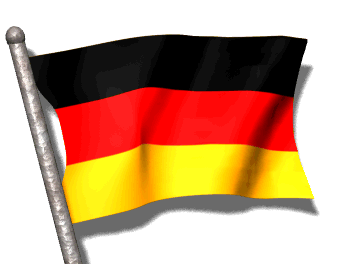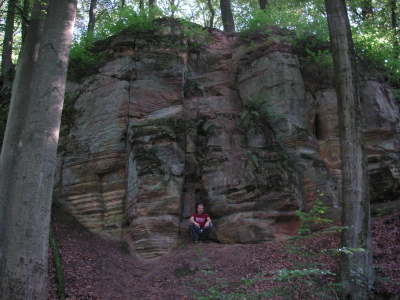Dieser Cache führt dich zu
einer geologischen Besonderheit im Burgwald.
Bitte lass das Cachemobil bei folgenden Koordinaten
stehen:
N 50° 56.011 und E 8°
50.333
This cache shows you a
geological peculiarity of the Burgwald region.
Please leave your car at:
N 50° 56.011 and E 8°
50.333


Großer
Badenstein
Der große Badenstein und
sein kleiner Bruder, der kleine Badenstein, sind geologische
Besonderheiten im Burgwald, der überwiegend aus Bunsandstein
besteht. Im Erdzeitalter Trias vor etwa 220 Millionen Jahren
lagerten sich Sedimente aus dem Rheinischen Schiefergebirge in das
germanische Becken ab. Es entstand eine bis zu 421 m hohe
Buntsandsteinplatte, die in mehrere Stücke zerbrach als das Gebiet
im Tertiär eine tektonische Anhebung erfuhr. Diese Stücke wurden
dann zu den Bergen und Hügeln des heutigen Burgwalds.
Doch die Buntsandsteinplatte wird von einigen wenigen Basaltmassen
wie dem großen und dem kleinen Badenstein durchbrochen. Die
Erhebungen der breits abgetragenen Basaltsteinbrüche sind noch
deutlich zu erkennen, wobei der große Badenstein einem Krater
gleicht. Seine Blaubasaltsteine wurden im 18. Jahrhundert in
Rosenthal und Wetter zur Ausbesserung des Straßenbelags verwendet.
1830 schloss man die Steinbrüche.
Die Bezeichnung "Baden" entstammt einem althessischen Wort und
bedeutet "nützen" oder "helfen"
Basalt
Basalt ist ein basisches
(SiO2-armes) Ergussgestein, das vor allem aus einer Mischung von
Eisen- und Magnesium-Silikaten mit Olivin und Pyroxen sowie
calciumreichen Feldspat (Plagioklas) besteht. Es entsteht, wenn
dünnflüssiges, kieselsäurearmes Magma an der Erdoberfläche austritt
und relativ schnell erkaltet. Das Gestein ist grauschwarz bis
schwarz und durch die Abkühlung häufig eckig-säulig
zergliedert.
Buntsandstein
Der Begriff Buntsandstein
ist etwas verwirrend, bezeichnet er doch keinen bestimmten Typ
Sandstein (wie z.B. buntgefärbter Sandstein), sondern eine
Gesteinseinheit, die zwar überwiegend aus Sandsteinen aufgebaut
ist, daneben aber noch weitere klastische Sedimente
enthält.
Um diesen
Cache zu loggen, mache ein Foto von dir vor der
rechten
Buntsandsteinwand und beantworte folgende
Fragen:
1. Welche
Höhe zeigt dein GPS an den angegebenen Koordinaten?
2. An der
linken
Buntsandsteinwand gibt es eine größere
Einritzung, die wie eine Zahl aussieht. Welche Zahl ist dort
dargestellt?
Die
Antworten sende bitte an unsere email-Adresse (siehe
Profil).
Logs ohne
Bild upload bzw. ohne eine email-Beantwortung der Fragen werden
gelöscht!
Es können
gerne auch weitere Bilder hochgeladen werden, achte nur bitte
darauf, dass sie nicht die Antwort auf Frage 2 verraten. Spoiler
müssen wir leider entfernen.
Du kannst direkt loggen, bei
Problemen melden wir uns.


Great
Badenstein
The so called 'great
Badenstein' and his small brother the 'small Badenstein' are
geological peculiarities of the local region named 'Burgwald'. This
area mostly consists of Bunter sandstone. About 220 million years
ago during the geological era Trias sediments of the Rhenish Slate
Mountains deposited to the Germanic basin. Out of these sediments a
Bunter sandstone plate arose which was up to 421 metres high and
burst into many pieces when the region experienced a tectonic
lifting in tertiary. Finally these pieces developed to the
mountains of present-day 'Burgwald'.
But the plate of Bunter sandstone is being broken away by a few
masses of basalt such as the 'great Badenstein' and the 'small
Badenstein'. The rise of the already excavated basalt quarries is
still readily identifiable, whereas the 'great Badenstein'
resembles a crater. In the 18th century its blue basalt stones were
being used for repairing the roads in 'Rosenthal' and 'Wetter'. The
quarries were closed in 1830.
The term 'Baden' originates from an old Hessian word meaning
something like 'to be useful' or 'to help'.
Basalt
Basalt is an alkaline
(SiO2-poor; Silicon dioxide poor) effusive rock. It consists
particularly of a mixture of iron and magnesium-silicates (salts
and their condensates) with olovine (minerals of the class of
silicates) and pyroxene (minerals from the class of silicates and
germanates) as well as calcium-rich feldspar (plagioclase). Basalt
develops if thin fluid, silicic acid-poor magma withdraws at the
earth's surface and cools down relatively fast to basalt lava. The
colour of the rock is greyish black to black and due to the cooling
down it is formed like angled columns.
Bunter
sandstone
The name 'Bunter' derives
from the German term 'Buntsandstein', 'bunt' meaning 'variegated'
or 'colourful', referring to the colour of the sandstone deposit,
which varies from reddish to greenish. However Bunter doesn't
describe a special sort of sandstone but a mixture of sandstone and
other clastic sediments, e.g. mudstone.
To log this
cache please take a picture of yourself in front of the
right wall of Bunter
sandstone and answer the following
questions:
1. Which
height does your GPS show at the given coordinates?
2. At the
left wall of Bunter
sandstone it looks like someone engraved a large number into the
rock. What number is it?
If you are
done please send the answers to our email-address (check our
profile).
Logs without
a picture upload or without sending the answers to our email will
be deleted.
Feel free to
add more pictures but please do not spoil question number 2
otherwise we have to delete the log.
You can log your visit directly, if there are any problems we will
contact you.